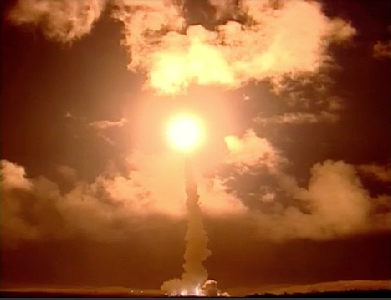
After a 24-hour delay, Friday night’s successful 7:19 p.m. PST launch of the classified NROL-35 payload for the National Reconnaissance Office, atop an Atlas V 541 booster from Space Launch Complex (SLC)-3E at Vandenberg Air Force Base, Calif., has concluded a spectacularly successful run of 14 missions for United Launch Alliance (ULA) in 2014. This is surpassed only by 2009, when the Centennial, Colo.-based launch services organization lofted a total of 16 vehicles. In the last 12 months, ULA—which was formed back in December 2006 as a merger between Boeing and Lockheed Martin—has delivered a record-breaking nine Atlas Vs, together with four Delta IVs and a single Delta II, and placed NASA, military, and civilian payloads into low, medium, and geostationary Earth orbits. In doing so, ULA has added to an impressive legacy, flying its 80th overall mission in its eight-year history, the 50th Atlas V, the 25th Delta IV, and the first Delta II in almost three years.
As described in AmericaSpace’s preview article, the heavyweight NROL-35 required the “541” variant of the workhorse Atlas V, equipped with a 17.7-foot-diameter (5.4-meter) payload fairing, four strap-on solid-fueled rocket boosters, and a single-engine Centaur upper stage. Capable of delivering up to 38,450 pounds (17,440 kg) into low-Earth orbit and up to 18,230 pounds (8,290 kg) into geostationary transfer orbit, the 541 is the second most powerful Atlas V variant currently in active service and was previously employed on just two occasions: to launch NASA’s Mars Science Laboratory (MSL) and the enormously successful Curiosity rover to the Red Planet in November 2011, followed by the NROL-67 classified payload for the National Reconnaissance Office in April 2014. Both of those missions flew from Cape Canaveral Air Force Station, Fla., making NROL-35 the most powerful Atlas V ever to fly from the West Coast.
“We are honored to deliver the NROL-35 spacecraft to orbit together with our customers, the NRO Office of Space Launch and the Air Force,” said Jim Sponnick, ULA vice president of Atlas and Delta Programs. “This mission was launched on the most powerful Atlas ever launched from California. This was enabled by the addition of the four solid rocket motors, providing additional performance as required to meet our customer’s needs.”
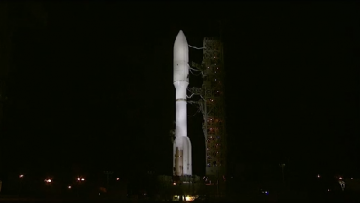
Processing of this mission got underway in earnest in September, as work to assemble the Atlas’ central Common Core Booster (CCB) and four solid-fueled rockets commenced. Two weeks ago, in late November, hidden within its bulbous payload fairing, the NROL-35 spacecraft was transferred to the Horizontal Integration Facility (HIF) at Vandenberg for installation atop the launch vehicle. On Wednesday, 10 December, ULA marched smoothly through its Launch Readiness Review (LRR), targeting an opening launch attempt at 7:17 p.m. PST on Thursday. However, weather at the launch site—which lies in a mountain-ringed location, about 9.2 miles (14.8 km) northwest of Lompoc, Calif.—was predicted to be iffy, with heavy rain expected, winds of up to 60 mph (100 km/h) and just a 10 percent likelihood of acceptable conditions at T-0. By 1:40 p.m. PST, “due to predicted violations of multiple weather criteria,” the launch was scrubbed and rescheduled for 7:13 p.m. PST Friday. The rollback of the Mobile Service Tower (MST) had not taken place and Vandenberg officials cautioned that the chances of a successful launch on Friday carried only a 40 percent probability of acceptable weather.
Nonetheless, efforts to launch NROL-35 on Friday shifted into high gear and the 191-foot-tall (58.3-meter) Atlas V 541 stack underwent electrical, mechanical, and fluid connections and flight control systems checkouts at SLC-3E. Unlike Cape Canaveral, where the rocket is assembled in the Vertical Integration Facility, some 1,200 feet (360 meters) from the pad, the Vandenberg MST is actually situated on SLC-3E and rolls back before launch. This enables the vehicle to be assembled and maintained in launch position.
At T-2 hours and 30 minutes, a built-in hold in the countdown occurred, prior to the loading of cryogenic propellants into the CCB and the Centaur. Liquid oxygen was transferred into the tanks of the upper stage and had entered a “topping” mode to replenish the effects of cryogenic boil-off by T-64 minutes. Meanwhile, the three-step process to fuel the CCB with liquid oxygen and a highly refined form of rocket-grade kerosene (known as “RP-1”) got underway, stepping smartly through Slow Fill, Fast Fill, and Topping milestones. By 6:53 p.m. PST, fueling concluded. With all tanks confirmed at flight levels, the final checkout of the Flight Termination System (FTS)—which is tasked with destroying the vehicle in the event of a major accident during ascent—was performed and the ascent software was updated. However, the weather outlook had deteriorated to about 30 percent favorable and a revised T-0 of 7:19 a.m. was announced shortly afterwards.
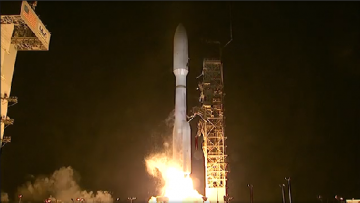
A final “Go-No Go” poll of all 27 stations was conducted by the ULA Launch Control Team at 7:13 p.m., producing a definitive “Go for Launch,” and at 7:15 p.m. PST, four minutes before the planned T-0, the Terminal Countdown was initiated. During this phase, the Atlas V transitioned to internal power and at T-60 seconds the Launch Control System was enabled and the vehicle’s computer’s assumed primary command of all critical functions. Two and a half seconds before liftoff, the Russian-built RD-180 engine at the base of the CCB roared to life, generating 860,000 pounds (390,000 kg) of propulsive yield. Combined with the four strap-on boosters—each of which punches out 285,500 pounds (129,500 kg) of thrust—the most powerful Atlas V ever to fly from Vandenberg was released from SLC-3E and commenced its climb-out from the launch complex at T+1.1 seconds. With the characteristic loud crackle of the solid-fueled boosters, AmericaSpace’s Launch Tracker noted, the 14th ULA mission of 2014 was on its way to orbit.
Shortly after clearing the tower, it executed a combined pitch, roll, and yaw program maneuver to position itself onto the proper flight azimuth to inject NROL-35 into orbit. As described in the Notice to Airmen and Mariners (NOTAM) for the mission, several sea-closure areas were activated through 14 December, along the western coastal waters off Baja California and extended southwards into a virtually uninhabited stretch of the Pacific Ocean, far to the northwest of the Galapagos Islands, providing further evidence of the suspected highly elliptical, “Molniya-type” nature of NROL-35’s orbital destination. “Navigational warnings and the four-minute shift in launch time on subsequent days,” explained Spaceflight101, “confirms that NROL-35 was heading to a highly elliptical orbit with a fixed apogee over the Northern Hemisphere.” As expected for a classified mission, only the initial portion of ascent was covered live, before heading into a communications blackout, and confirmation of the successful insertion of the payload into orbit was revealed about 75 minutes later.
A little under a minute into the flight, with the RD-180 still burning hot and hard, the rocket burst through the sound barrier, at which point maximum aerodynamic stresses (colloquially known as “Max Q”) were experienced through the Atlas’ airframe. In response to this aerodynamic situation, the engine was temporarily throttled back to 95 percent of its rated performance. By about 90 seconds into the flight, the four strap-on boosters’ chamber pressures began to tail off and they were burned out and jettisoned in two pairs, over a roughly 2-second period, from the rapidly moving vehicle. At this point in the ascent, the Atlas V was traveling in excess of 4,500 mph (7,240 km/h).
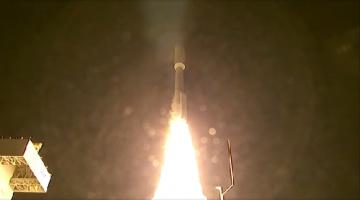
Approximately ten seconds prior to Booster Engine Cutoff (BECO), the Atlas V throttled down to a constant 4.6 G and the now-exhausted CCB separated from the stack at about 4.5 minutes into the ascent. “Following the cutoff of the Atlas V core booster, the mission updates have been stopped,” explained AmericaSpace’s Launch Tracker. “This is a standard operating procedure for the National Reconnaissance Office, where they use a number of tracks and deceptions in an attempt to disguise the orbital insertion of the NROL spacecraft.” The payload fairing was jettisoned at 7:24:15 p.m. PST and the turn then came for the Centaur—powered, for the first time on this mission, by Aerojet Rocketdyne’s liquid oxygen/hydrogen RL-10C engine—which carried the key responsibility for delivering the heavyweight NROL-35 payload into its required orbit. The Centaur’s engine is capable of restarting in flight, although the exact number of “burns” it actually executed remains unknown at present.
Thus was concluded ULA’s 14th mission of 2014, placing this year in second place for the highest number of vehicles ever launched by the Centennial, Colo.-based launch services organization in a single 12-month period. Only 2009 and its impressive tally of 16 Atlas V, Delta II, and Delta IV flights stands ahead of it, although that record is expected to be tied in 2015, when ULA plans an ambitious salvo of three Delta IVs, one Delta II, and as many as 12 Atlas Vs, including its first Orbital Sciences Corp. Cygnus cargo mission to the International Space Station (ISS).
Next year’s mammoth 16 launches will include two flights by the most powerful Atlas V currently in active operational service—the “551” variant, equipped with a 17.7-foot-diameter (5.4-meter) payload fairing, five strap-on solid-fueled rocket boosters, and a single-engine Centaur upper stage—to loft two members of the Multi-User Objective System (MUOS) constellation into orbit in January and August, on behalf of the Department of Defense. Additional tasks for the Atlas V include the fourth flight of the classified X-37B Orbital Test Vehicle (OTV) mini-shuttle and a number of military, scientific, and commercial satellites. Meanwhile, the Delta II will launch NASA’s Soil Moisture Active Passive (SMAP) environmental research mission in January and the Delta IV Medium is slated to deliver three military payloads into orbit. Thirteen of the missions (including all but one of the planned Atlas Vs) are expected to originate from Cape Canaveral Air Force Station and just three from Vandenberg Air Force Base.
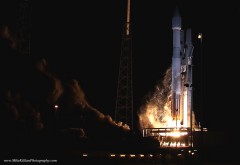
Yet as 2014 enters its final weeks, ULA can reflect upon a year which has brought it tremendous success and a measure of vindication in the face of harsh criticism. The company kicked off its manifest in January by launching NASA’s latest Tracking and Data Relay Satellite (TDRS-L)—also highlighted in an expansive AmericaSpace Photo Feature—atop an Atlas V 401 to support both human and robotic space missions. Less than a month later, the Delta IV Medium+ 4,2, equipped with a 13-foot-diameter (4-meter) payload fairing and two strap-on solid-fueled boosters, delivered the fifth member of the Global Positioning System Block IIF network (GPS IIF-5) into medium Earth orbit. The mission marked the triumphant return to flight for the Medium, which had suffered a period of unexpectedly reduced upper-stage thrust during an October 2012 launch and, although it flew again the following year, succumbed to several months of delays in the wake of a Phase II investigation into the original incident. As well as bringing the Medium back to full flight status, the GPS IIF-5 mission marked the 25th overall launch of a Delta IV since the vehicle’s maiden voyage, back in November 2002.
ULA next successfully staged two missions within a single week of each other, boosting an Atlas V 401 from Vandenberg on 3 April with the Defense Meteorological Satellite Program (DMSP)-19 satellite and the long-delayed NROL-67 classified payload for the National Reconnaissance Office, atop an Atlas V 541 from Cape Canaveral Air Force Station on 10 April. Interestingly, DMSP-19 marked ULA’s 80th launch in just over seven years of operations. Remarkably, and in line with the organization’s “Perfect Product Delivery” motto, none of those missions had produced an outright failure and loss of payload, despite a number of upper-stage troubles which affected both the Atlas V and Delta IV.
Although launching two missions with a seven-day interval was not a “first”—ULA had previously achieved this on three occasions in 2007 and once in both 2008 and 2011—a new record was established in May 2014, when two vehicles were despatched within just five days of each other, from the same launch site. On 17 May, a Delta IV Medium+ 4,2 departed the Cape’s Space Launch Complex (SLC)-37B, carrying the GPS IIF-6 satellite, and was followed on 22 May by an Atlas V from the Cape’s SLC-41, laden with the classified NROL-33 payload. The latter was widely suspected to be an upgraded Satellite Data Systems (SDS) military communications satellite, bound for geostationary transfer orbit.
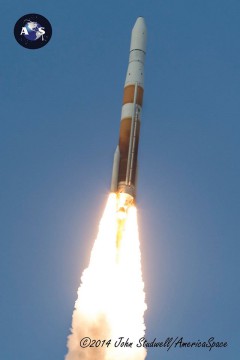
Only weeks after the establishment of the five-day record, ULA smashed its own personal best, by delivering both the Air Force Space Command (AFSPC)-4 and GPS IIF-7 missions within just four days of one another. Riding the Delta IV Medium+ 4,2 from SLC-37B at the Cape, the AFSPC-4 spacecraft—which comprised two Geosynchronous Space Situational Awareness Program (GSSAP) satellites and a single Automated Navigation and Guidance Experiment for Local Space (ANGELS) satellite—was launched on 28 July, after several days of weather-related delays, followed by GPS IIF-7, aboard an Atlas V 401 from SLC-41 on the evening of 1 August. The successful launches meant that its fleet of boosters had staged three times as many missions in 2014 as its leading competitor, SpaceX, which had attempted earlier in the year to initiate a legal challenge to ULA’s perceived monopoly of the military launch market. Responding to this criticism with a dignified, yet punishing, “Results over Rhetoric” salvo, ULA’s position was strengthened in July when the U.S. Government formally requested the U.S. Court of Federal Claims to dismiss SpaceX’s lawsuit.
Dovetailed into the rapid-fire Atlas V and Delta IV campaign came the return to flight, on 2 July, of the long-serving Delta II, which was making its first mission for almost three years. Original plans called for it to be phased out of service, following Air Force plans to discontinue its use of the vehicle, but in September 2011 it was announced that NASA had added the Delta II to its NASA Launch Services (NLS)-II contract, which provided for the delivery of payloads weighing about 550 pounds (250 kg) into minimum circular orbits of 125 miles (200 km). Launching from SLC-2W at Vandenberg, the Delta II successfully transported NASA’s Orbiting Carbon Observatory (OCO)-2 spacecraft aloft and is currently also manifested to launch the Solar Moisture Active Passive (SMAP) in January 2015.
The return to flight of the Delta II deserves a note to recognize the accomplishments of all three of ULA’s boosters. With a launch history in excess of 150 missions, the Delta II is one of the most reliable U.S. vehicles currently in service and under ULA’s watch it has lofted the Dawn spacecraft to the protoplanet Vesta and dwarf planet Ceres in September 2007 and the Kepler observatory in March 2009. Meanwhile, the Atlas V has boosted the Juno spacecraft and the Mars Science Laboratory (MSL) and Curiosity rover for NASA and the Delta IV—in its Medium and Heavy configurations—has supported a variety of satellites for reconnaissance, weather, communications, and early-warning purposes. At the end of 2014, ULA has staged 91 missions in its eight years of operation, including 27 Delta II missions, 43 Atlas V missions, and 21 Delta IVs. And when one extends the history of those three vehicles beyond ULA’s tenure, the Delta II has flown 152 times since its maiden voyage in February 1989, the Atlas V 51 times since its first mission in August 2002, and the Delta IV 28 times since the dawn of its operational life, back in November 2002.
Twelve days after launching GPS IIF-7, ULA launched the WorldView-3 Earth-imaging satellite from Vandenberg on 13 August, the classified CLIO mission from the Cape on 16 September and the GPS IIF-8 payload from the Cape on 29 October. All three rode atop Atlas V 401 boosters. However, the definitive flight of 2014 was the return of the Delta IV Heavy for its eighth career launch on 5 December, carrying NASA’s Orion spacecraft on its inaugural shakedown voyage in a highly elliptical Earth orbit. With the NROL-35 mission having wrapped up ULA’s 2014 manifest—and after what Col. Keith Balts, commander of the 30th Space Wing at Vandenberg described as “an amazing year”—the stage is now set for a record-tying 16 launches in 2015.
Want to keep up-to-date with all things space? Be sure to “Like” AmericaSpace on Facebook and follow us on Twitter: @AmericaSpace
Missions » NROL » NROL-35 »




Outstanding. It’s not often noticed, but smaller rockets such as these launch enough cumulatively to match or exceed the gross tonnage of a comparative HLV launcher. This flight rate already exceeds SLS’s hauling rate for the foreseeable future when it becomes operational in the next decade. Had all these launches been lofting lunar mission components and fuel in a multi-launch exploration architecture then we could have seen lunar missions occurring every year or two, or even more with increased procurement.
Here’s one example of a proposal to use the Delta 4 Heavy, the same rocket that launched the recent EFT-1 mission, to perform lunar missions:
http://www.spacelaunchreport.com/moonslo.html